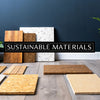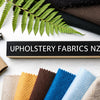Best Curtain Fabric Material Guide for Your Home
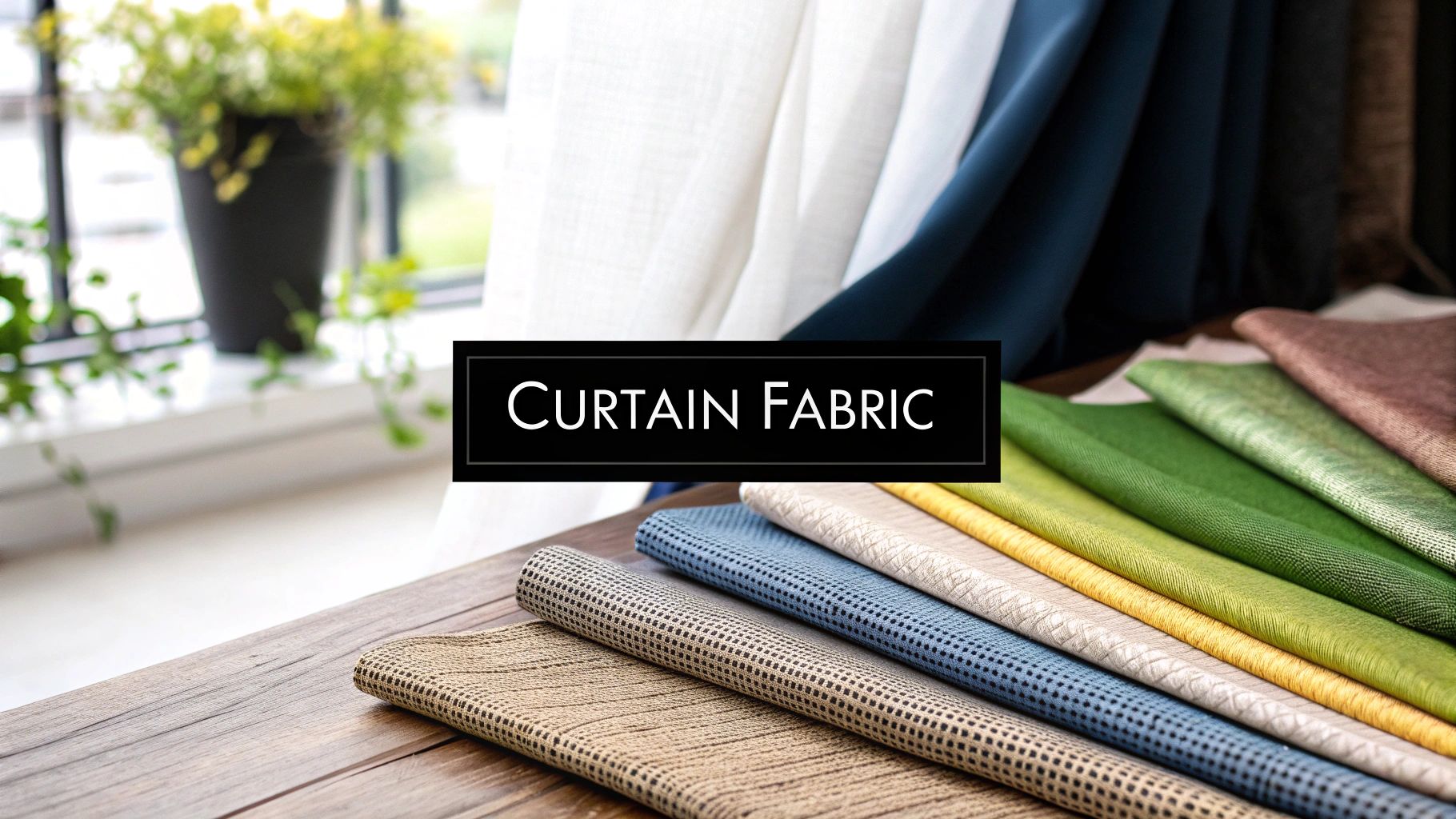
Understanding What Makes Curtain Fabric Material Special
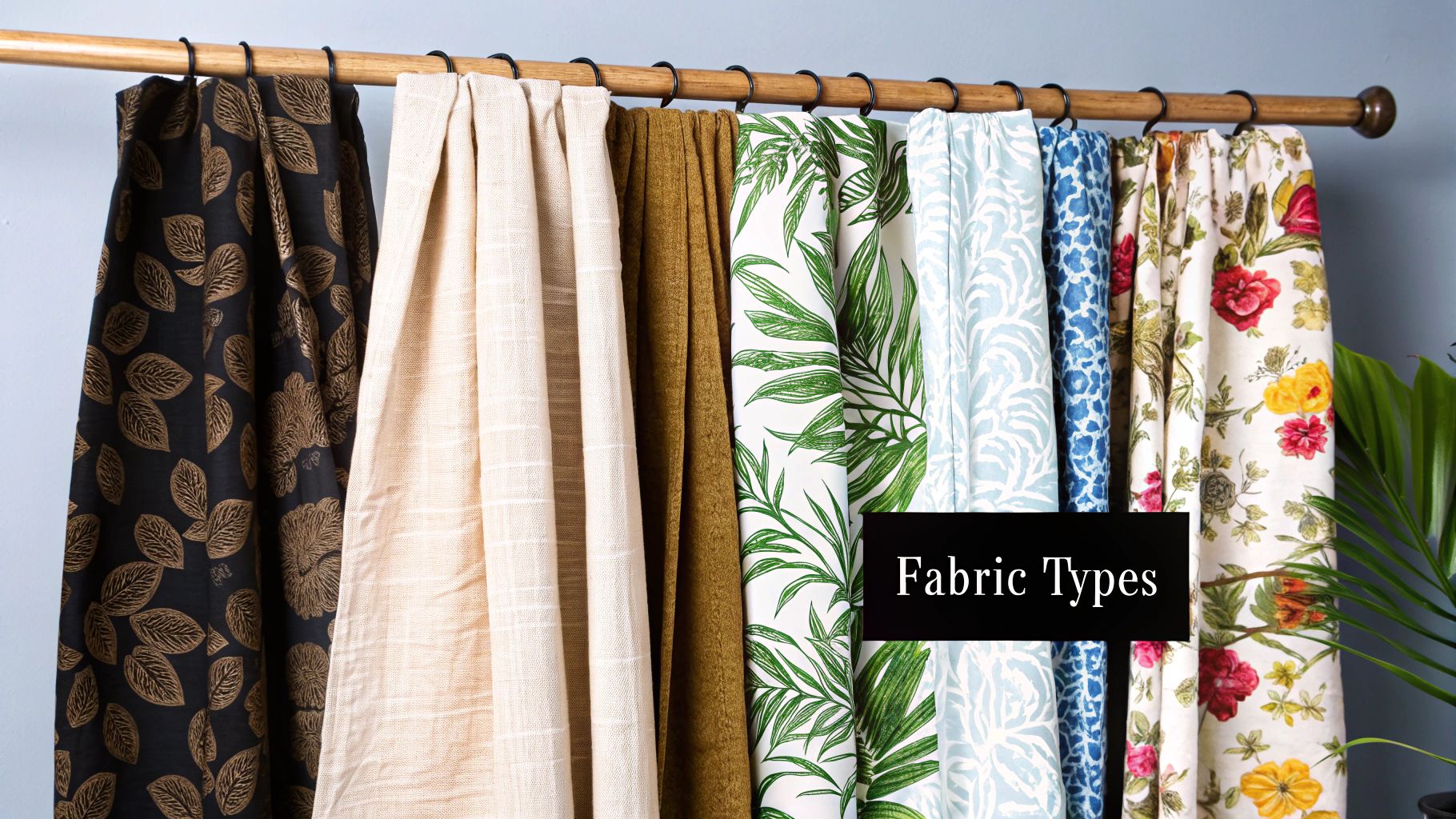
Ever been tempted to transform a beautiful shirt fabric into stunning curtains? It's a tempting thought, but clothing fabric and curtain material are surprisingly different. Think of curtain fabric as a high-performance athlete, expertly engineered for multiple tasks: privacy, light control, insulation, and style. Clothing, on the other hand, mainly needs to look and feel good.
Curtain fabrics endure a lot – constant sunlight, changing humidity, and the relentless tug of gravity. They need to hold their shape and color over years of use. That's where the fabric's inherent properties become so important.
Imagine the difference between a thin cotton sheet and a sturdy linen tablecloth. One wrinkles easily, the other holds its form. That difference highlights the importance of textile engineering in creating durable and functional curtains.
The Science Behind High-Performing Curtain Fabrics
This specialized engineering transforms harsh sunlight into a soft glow, lowers energy bills by insulating your home, and can even quiet street noise. Fiber density, weave structure, and special treatments aren't just about aesthetics; they directly affect performance.
Think of a tightly woven fabric as a sound barrier, absorbing sound waves like a sponge. A loosely woven fabric, conversely, lets light and air filter through, creating a breezy summer vibe.
This focus on function is reflected in market trends. The New Zealand curtains and blinds market is projected to hit NZD $84.98 million by 2025, growing at 1.21% annually. This growth is fueled in part by the increasing demand for energy-efficient and sustainable window coverings. Discover more insights about the NZ curtain market. It shows how important curtain fabric has become in creating comfortable and eco-conscious homes.
Spotting Quality in Curtain Fabric
Learning to identify quality in curtain fabric is key to long-lasting satisfaction. It’s about knowing the difference between a fabric that will drape beautifully for years and one that fades or loses its shape quickly.
These quality indicators can be subtle, like the tightness of the weave or the weight of the material. But they're essential for making smart choices. For example, a heavier fabric usually means a denser weave, which offers better light blocking and insulation.
By understanding these aspects of curtain fabric, you can go beyond simply choosing something that looks nice. You can start to appreciate the science and engineering that make a high-performing and durable window treatment. This knowledge helps you choose curtain fabrics that not only enhance your home’s beauty but also improve its comfort, energy efficiency, and overall value. Next, we'll explore the specific properties of natural curtain fabric materials.
Natural Curtain Fabric Material: Time-Tested Choices That Deliver

The infographic above gives a quick visual guide to the durability of cotton, linen, and velvet curtains. Velvet comes out on top with a 9/10 rating, followed by linen at 7/10 and cotton at 6/10. This highlights how tough these fabrics are, especially velvet, which is a great pick for busy areas.
Choosing natural curtain fabrics is a bit like selecting ingredients for a favorite recipe. Each material brings its own special something to the finished product. From light and airy cotton to the luxurious drape of silk, these fabrics have a richness that synthetics often can't match. But just like with cooking, picking the right fabric means understanding its pros and cons.
Let's explore some popular choices:
Cotton: The Versatile All-Rounder
Cotton is the everyday hero of curtain fabrics – adaptable and easy to care for. It's like the dependable t-shirt of your window coverings. Whether you prefer crisp poplin or relaxed canvas, cotton offers breathability and a natural feel. This makes it a go-to for bedrooms, especially kids' rooms where spills and frequent washes are just part of life.
Linen: Effortless Elegance and Coastal Charm
Linen adds a touch of casual sophistication to any room. Think of that perfectly worn-in linen shirt – effortlessly chic and comfortable. Its slightly wrinkled texture brings to mind breezy coastal homes. Linen is also durable and develops a lovely character over time, becoming even more appealing with age. If you're after relaxed elegance, linen is a strong contender.
Wool: Nature's Insulator
Wool is a natural insulator, keeping you warm in winter and surprisingly cool in summer. Its fibers trap air, creating a barrier against both heat and cold. This makes wool curtains a smart investment, especially in colder climates, as they can help regulate temperature and possibly even lower your energy bills.
Silk: The Luxury Choice
Silk is the undisputed champion of luxury. It drapes beautifully and catches the light in a way that elevates any space. Think of a flowing evening gown – elegant and eye-catching. Silk adds a touch of opulence, making it perfect for formal living rooms or dining areas. For more ideas on living room curtains, check out our guide: Top 7 Best Curtain Material for Living Room.
Emerging Natural Options: Bamboo and Hemp
Beyond the classics, eco-conscious homeowners are increasingly turning to bamboo and hemp. These sustainable materials offer unique textures and advantages, expanding the world of natural curtain fabrics. They represent a growing trend toward greener choices in interior design, offering style and contributing to a healthier planet.
To help you compare these wonderful natural materials, we've put together a handy guide:
Natural Curtain Fabric Material Performance Guide
This table compares the durability, maintenance, light control, and ideal room use for different natural curtain fabrics to help you make an informed choice.
| Material | Durability Rating | Light Control | Care Level | Best Room Use | Investment Level |
|---|---|---|---|---|---|
| Cotton | 6/10 | Moderate | Easy (Machine Washable) | Bedroom, Kids' Room | Low to Medium |
| Linen | 7/10 | Moderate to High | Moderate (Hand Wash Recommended) | Living Room, Bedroom | Medium |
| Wool | 8/10 | High | Moderate (Dry Clean Recommended) | Living Room, Bedroom | Medium to High |
| Silk | 5/10 | Moderate | High (Dry Clean Only) | Formal Living Room, Dining Room | High |
| Bamboo | 7/10 | Moderate | Easy (Wipe Clean) | Living Room, Bedroom, Patio | Medium |
| Hemp | 8/10 | Moderate to High | Moderate (Machine Washable) | Living Room, Bedroom | Medium |
As you can see, each fabric has its strengths. Cotton is easy to care for, while wool offers excellent insulation. Linen provides relaxed elegance, and silk brings pure luxury. Bamboo and hemp stand out for their sustainability. Considering these factors will help you choose the perfect natural fabric for your curtains.
Synthetic Curtain Fabric Material: Modern Solutions That Actually Work
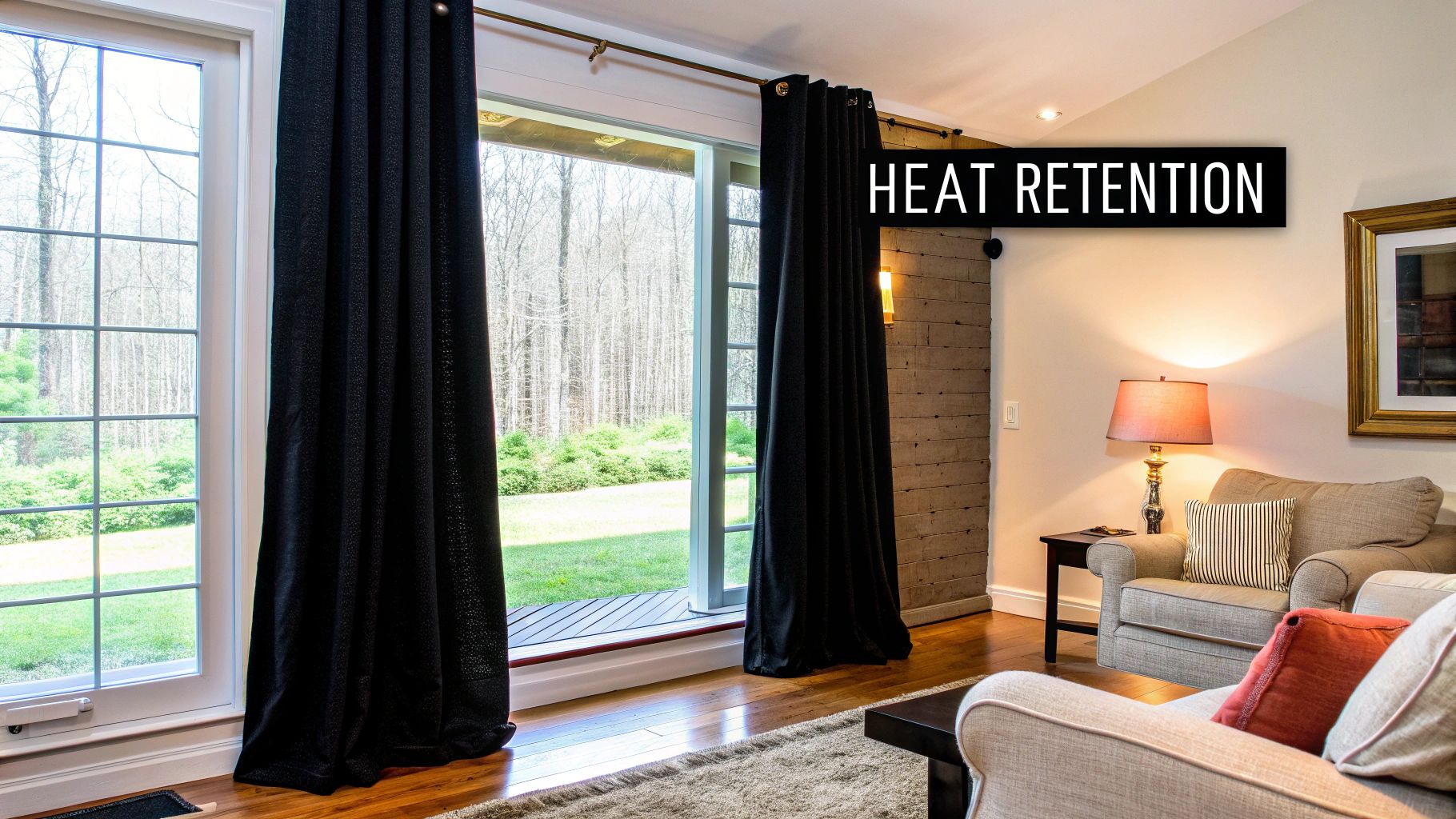
Synthetic curtain fabrics sometimes get a bad rap, often seen as the less desirable, budget-friendly choice. But let's rethink that. Think of modern synthetic fabrics as the high-performance athletic wear of the window world. They're designed to handle challenges that natural fibers just can't, offering practical benefits for how we live today.
Polyester: A Transformation Story
Polyester’s reputation has undergone a real transformation. Remember those stiff, scratchy polyester curtains of the past? Well, things have changed. Today's polyester is a different story. It offers impressive fade resistance, keeping your colours vibrant even under the strong NZ sun. It's also moisture-resistant, perfect for humid spots like bathrooms and kitchens. And the wrinkle recovery? Say goodbye to ironing!
Acrylic: The Wool Mimic
Acrylic brings you the cozy warmth of wool without the drawbacks like moth damage or expensive dry cleaning. This makes it a smart choice for bedrooms or living rooms, especially in cooler parts of NZ, offering both comfort and practicality. Plus, newer synthetic blends can even mimic the look and feel of natural fabrics like linen or silk, giving you a luxurious aesthetic at a more affordable price.
Performance Advantages of Synthetic Curtain Fabric Material
This is where synthetics really shine. They often outperform natural materials in important ways. They're more resistant to stains – a lifesaver for families with kids or pets. They can handle frequent washing without shrinking or losing their shape, staying fresh and looking their best. And unlike some natural fibers that can react to humidity, synthetics offer consistent performance no matter the weather.
Value Versus Budget: Making Informed Choices
It's important to remember that not all synthetic fabrics are created equal. Some budget options might not hold up over time, while premium synthetic materials offer real value. Understanding the differences in construction, fiber quality, and finishing is key.
Think of it like buying two seemingly identical white t-shirts. One shrinks and fades after a few washes; the other stays bright and true to size. The same applies to curtain fabrics. Looking at real performance data from independent testing and hearing from interior designers about which materials perform best in real homes can help you make a smart choice. Next, we'll explore the best of both worlds: blended curtain fabrics.
Blended Curtain Fabric Material: Getting The Best Of Both Worlds
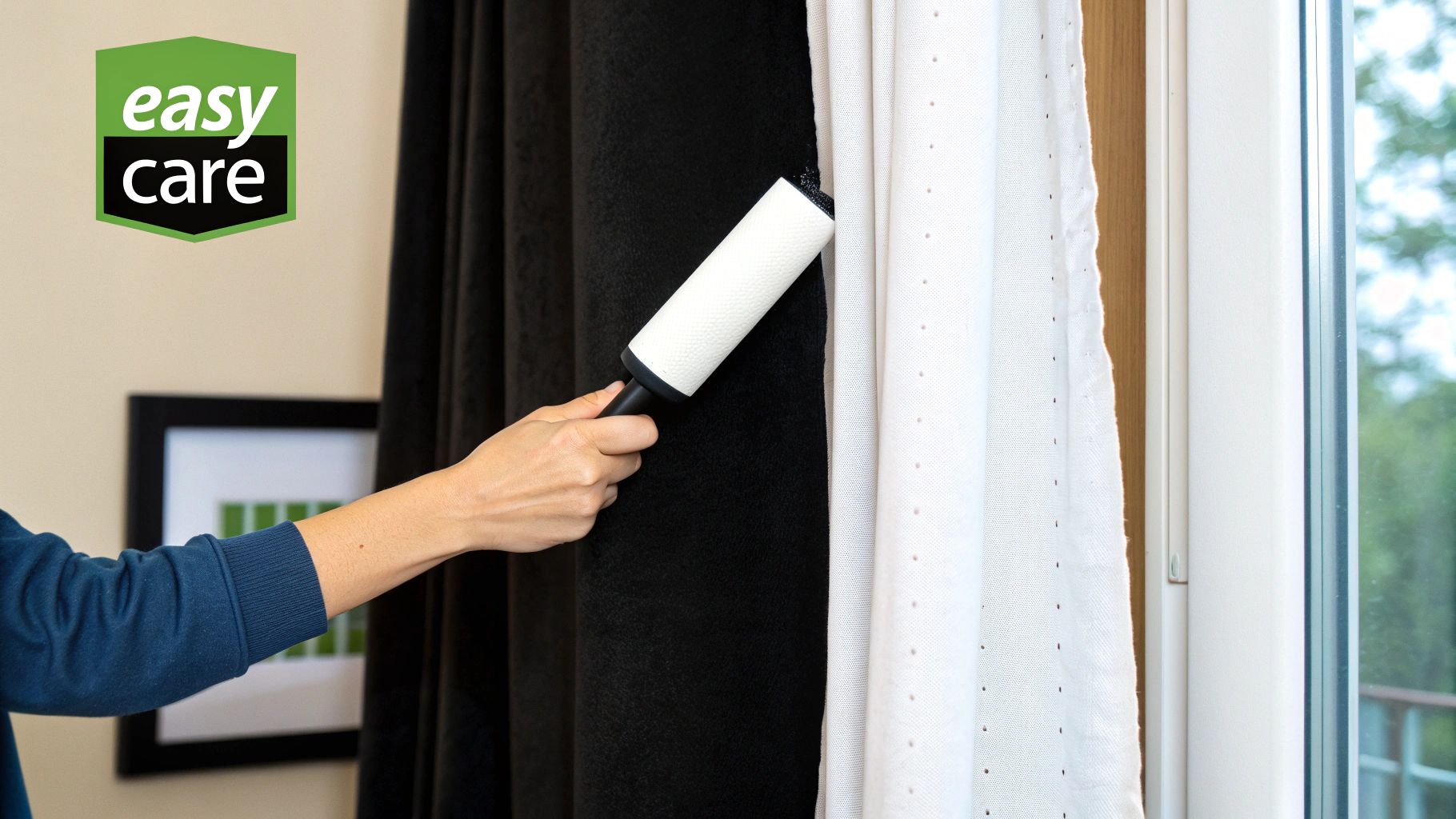
Imagine the perfect curtain fabric. It has the soft breathability of natural cotton but the wrinkle-free resilience of polyester. Or perhaps the elegant drape of linen without the constant ironing. This is the beauty of blended fabrics – combining different fibers to create a textile with the best of both worlds.
Decoding the Blend Ratios
Think of blend ratios like a recipe. A 60/40 cotton-polyester blend, for example, gives you a good dose of cotton's breathability and natural feel, balanced with polyester's durability and wrinkle resistance.
But changing the ratio shifts the final result. An 80/20 blend of the same fibers will feel remarkably similar to pure cotton, while still enjoying a touch of polyester's strength. Understanding these ratios is key to predicting how the fabric will behave in your home. It’s like understanding wine labels - once you know what you're looking at, you can pick the perfect bottle (or curtain fabric!). This knowledge helps you choose the best curtain fabric material for your particular needs. You might be interested in: Top 7 Fabric for Curtain Ideas in 2025.
The Power of Combining Fibers
Blending fibers isn't just about balancing pros and cons; it's about creating something entirely new. A linen-cotton blend, for instance, captures the relaxed, casual look of linen but with a better structure and fewer wrinkles.
Even a small addition can make a big difference. Adding just 5% elastane can drastically improve a fabric's drape and give it that spring-back-into-shape quality. These seemingly small tweaks can significantly impact how your curtains look and perform over time.
Popular Blend Combinations and Their Benefits
- Cotton-Polyester: This dynamic duo is the most common blend, offering a practical balance of comfort, durability, and easy care.
- Linen-Cotton: This blend combines the laid-back aesthetic of linen with the easy maintenance of cotton.
- Silk-Cotton: Want a touch of luxury? This blend adds a subtle sheen and luxurious feel to cotton's practicality.
- Polyester-Viscose: This combination offers a soft drape and wrinkle resistance, often at a more budget-friendly price.
Care Techniques for Blended Fabrics
Caring for blended fabrics requires a little bit of detective work. Consider the needs of each fiber in the mix. A cotton-linen blend, for instance, will benefit from gentle washing and air drying. This helps prevent shrinkage and maintains that lovely linen texture.
Always check the care label—it’s your guide to keeping your curtains looking their best. By understanding the unique qualities of blended fabrics, you can confidently choose the best material for your needs, whether it’s light control, insulation, or simply finding that perfect drape.
Sustainable Curtain Fabric Material: Making Responsible Choices
Choosing sustainable curtain fabric isn't as simple as picking natural over synthetic. It's a bit like comparing a petrol car for short trips against an electric car charged with coal power – the full story is key. Organic cotton, for example, avoids harmful pesticides and uses less water while growing. But conventionally grown cotton curtains can sometimes last much longer, balancing out the initial environmental cost.
Then there's polyester made from recycled plastic bottles. This clever approach keeps waste out of landfills and often creates curtains that outperform and outlast some natural options. It really highlights the need to look at a product's entire life cycle. You might also be interested in: Linen: A Sustainable Choice.
Lifecycle Analysis: From Fiber to Disposal
True sustainability means thinking beyond the initial purchase. Lifecycle analysis looks at resource use from the moment raw materials are extracted to the product’s eventual disposal. This includes energy use, water consumption, and the environmental effects of manufacturing. We need to consider the real environmental impact, not just an "eco-friendly" label.
For instance, some fabrics need heavy processing and chemical treatments, which cancels out the benefits of a natural fiber. Others, like recycled polyester, might seem less "natural" at first glance, but end up contributing less waste to landfills. In New Zealand, this growing focus on sustainability is changing the window covering market. It was valued at USD 83,750.47 thousand in 2023 and is expected to reach USD 116,393.57 thousand by 2031, with a 4.2% CAGR. This growth is fueled by a rising demand for sustainable choices. Discover more insights about the NZ window covering market.
Innovative Sustainable Options
The world of sustainable curtain fabrics is always changing. Tencel, made from sustainably harvested eucalyptus, drapes beautifully and feels wonderfully soft, all while using less water and energy than traditional fabrics. Similarly, recycled polyester is a durable and versatile option with a smaller environmental footprint than virgin polyester.
These innovative materials are raising the bar, offering both performance and eco-friendly benefits. They prove that sustainable choices don’t have to mean sacrificing quality or style.
Longevity: The Key to True Sustainability
Perhaps the most forgotten part of sustainable fabrics is how long they last. A well-made curtain, even from conventionally produced materials, that lasts fifteen years is better for the environment than a so-called "sustainable" fabric you have to replace every three years. This shows the importance of buying quality and picking fabrics that suit your needs and environment.
Practical Strategies for Extending Curtain Life
Simple steps can dramatically extend the life of your curtains. Regular cleaning, protecting them from direct sunlight, and proper storage during seasonal changes all help maintain their beauty and function. These small efforts go a long way in reducing waste and getting the most out of your purchase. Plus, exploring end-of-life options, like recycling programs or repurposing old curtains for something new, helps keep textiles from ending up in landfills, completing the sustainability cycle.
Matching Curtain Fabric Material To Your Specific Needs
Choosing curtain fabric isn't just about aesthetics; it's about finding the right fit for your room, much like choosing the right shoes. A stunning pair of stilettos might look amazing, but they won't be much good on a hiking trail. Similarly, different rooms have different needs, calling for different curtain materials.
Light Control and Privacy: From Blackout to Bright
Think about the function of a room. In a bedroom, light blocking is key for a good night's sleep, especially for those working night shifts. Dense polyester blackout curtains can create a haven of darkness, even during the day. On the other hand, a living room might benefit from UV protection to shield furniture from the harsh New Zealand sun. Sheer linen curtains offer a lovely way to filter light while maintaining some privacy.
Thermal Performance and Energy Efficiency: Staying Cozy
Different fabrics offer varying levels of insulation. Heavy cotton or wool can be fantastic for keeping your home warm in winter and cool in summer, leading to potential energy savings. However, in warmer parts of New Zealand, lighter synthetic fabrics might be preferable for improved airflow and a cooler home.
Sound Absorption: Creating a Quiet Retreat
Don't overlook the power of sound absorption. If you live near a busy road, dense, textured fabrics like velvet can dramatically reduce noise, creating a more peaceful environment. Conversely, smooth, lightweight materials won't offer much in the way of acoustic benefits. Interestingly, most New Zealand curtain fabric caters to the local market, with exports remaining relatively low. In 2023, curtain exports (including drapes and blinds) totaled just $465 thousand, a 15.7% decrease from the previous year. Find more details on NZ curtain exports here. This local focus allows for a wider selection tailored specifically to Kiwi homes.
Choosing the Right Material for the Job: Avoiding Curtain Catastrophes
Choosing the wrong fabric can lead to some unfortunate outcomes. Imagine delicate silk curtains in a humid bathroom – a recipe for disaster! In a kitchen, with its temperature changes and potential for cooking splatters, a durable, washable synthetic or a blend is likely a more practical choice.
To help you navigate the world of curtain fabrics, we've compiled a handy table summarizing the key performance characteristics of different materials:
Curtain Fabric Material Functional Performance Matrix
| Material Type | Light Blocking | Thermal Control | Sound Dampening | Moisture Handling | UV Protection |
|---|---|---|---|---|---|
| Linen | Low | Moderate | Low | Moderate | Moderate |
| Cotton | Moderate | Moderate | Moderate | High | Moderate |
| Polyester | High (Blackout varieties) | Moderate | Moderate | High | High |
| Velvet | High | High | High | Moderate | Moderate |
| Silk | Low | Low | Low | Low | Low |
| Wool | High | High | High | Moderate | Moderate |
This table provides a quick overview of how different materials perform across key areas, allowing you to choose the best fit for your specific room needs. Remember to consider factors like humidity and potential for spills when making your decision.
Ultimately, selecting the ideal curtain fabric involves considering your priorities. Do you need maximum light blockage, superior insulation, or perhaps noise reduction is your main concern? Understanding these factors empowers you to create a space that's both beautiful and functional, from a lively family room to a tranquil bedroom sanctuary.
Your Complete Curtain Fabric Material Selection Strategy
Choosing the right curtain fabric doesn't have to be overwhelming. Think of it like putting together an outfit – you want something stylish, but also practical for the occasion. You wouldn't wear a ballgown to the gym, right? Similarly, delicate silk might not be the best choice for a bustling family room. This guide breaks down the process of choosing the perfect curtain fabric, step by step.
Defining Your Needs: A Step-by-Step Approach
First, consider what you really need from your curtains. Asking yourself these questions will help narrow down the choices:
- Light Control: Do you want a room bathed in sunlight, a softly lit sanctuary, or complete darkness?
- Privacy: Are you simply screening the view or seeking total seclusion?
- Insulation: Are you trying to keep warm air in during winter and cool air in during summer? Which rooms need the most help?
- Maintenance: How much time and effort are you willing to spend on cleaning? Kids and pets might call for fabrics that can handle a little more wear and tear.
- Longevity: Are you looking for a long-term investment or a quick update? Your timeline can influence your budget and fabric choices.
- Aesthetics: What's the overall style of your room? Modern, classic, bohemian, or something else entirely?
Learn more about our curtain selection process at Maak Home's curtain guide.
Evaluating Trade-Offs: Balancing Competing Priorities
Sometimes, you'll have competing priorities. You might crave natural light during the day but need privacy at night. A layered approach, combining sheer curtains with heavier drapes, can be a great solution.
Imagine a family with young children. Durability and easy cleaning become essential. A stain-resistant synthetic blend or a sturdy cotton might be the best bet, even if natural linen seems more appealing at first glance.
Insider Tips for Curtain Fabric Shopping
- Touch and Feel: Online photos can be deceiving. Visit a store and feel the fabric yourself. How does it drape? Is it soft or stiff?
- Check the Weave: A tight weave is usually more durable and blocks light more effectively.
- Look at the Back: The back of the fabric can reveal a lot about its quality. A true blackout lining should be completely opaque.
- Ask About Shrinkage: Natural fibers like cotton and linen can shrink after washing. Always check the care instructions.
Red Flags to Watch Out For
- Excessively Low Prices: If it seems too good to be true, it probably is. Be cautious of incredibly cheap fabrics, especially those marketed as natural or high-quality.
- Vague Descriptions: Avoid fabrics with unclear fiber content or descriptions that lack specifics.
- Poor Drape: If a fabric feels stiff or doesn't hang well in the store, it’s not likely to look any better at home.
Coordinating Fabrics and Staying Within Budget
Coordinating fabrics throughout your home can feel tricky. Think about using a consistent color palette or repeating patterns and textures to create a harmonious look. You can absolutely mix and match different fabrics while still maintaining a cohesive feel. And, of course, keep your budget in mind! A prioritized shopping list can help you avoid impulse buys.
By following this guide, you can choose curtain fabrics that not only look fantastic but also perfectly suit your lifestyle and needs. This thoughtful approach ensures your window treatments will be a source of long-term satisfaction, adding both beauty and practicality to your home. Start exploring the diverse selection of high-quality curtain fabrics at Maak Home and begin your transformation today.





